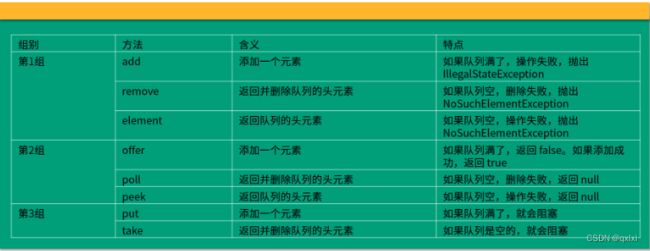【源码解析】聊聊阻塞队列之BlockingArrayQueue
阻塞队列
阻塞队列:顾名思义 首先它是一个队列,而一个阻塞队列在数据结构中所起的作用大致如下入所示。
- 当阻塞队列是空时,从队列中获取元素的操作将会被阻塞。
- 当阻塞队列时满的时,往队列里添加元素的操作将会被阻塞。
试图从空的阻塞队列中获取元素的线程将会被阻塞,直到其他的线程往空的队列插入新的元素。
同样,试图往已满的阻塞队列中添加新元素的线程同样也会被阻塞,直到其他的线程从队列中移除一个元素才可以插入队列中。
为什么使用阻塞队列 好处?
在多线程领域:所谓阻塞,在某些情况下会挂起线程(即阻塞),一旦条件满足,被挂起的线程又会自动被唤醒。
为什么需要BlockingQueue
好处是我们不需要关心什么时候需要阻塞线程,什么时候需要唤醒线程,因为这一切BolckingQueue都给你一手包办了,在concurrent包发布以前,在多线程环境下,我们每个程序员都必须去自己控制这些细节,尤其还要兼顾效率和线程安全,而这会给我们的程序带来不小的复杂度。
阻塞队列接口和实现类
| 实现类 | 特点 |
|---|---|
| ArrayBlockingQueue | 由数组结构组成的有界阻塞队列 |
| LinkedBlockingQueue | 由链表结构组成的有界(但大小默认值有Integer.MAX_VALUE)阻塞队列 |
| PriorityBlockingQueue | 支持优先级排序的无界阻塞队列 |
| DelayQueue | 使用优先级队列实现的延迟无界阻塞队列 |
| SynchronousQueue | 不存储元素的阻塞队列,也既单个元素的队列 |
| LinkedTransferQueue | 由链表结构组成的无界阻塞队列 |
| LinkedBlockingDeque | 由链表结构组成的双向阻塞队列 |
BlockingQueue
//阻塞队列
public interface BlockingQueue extends Queue {
// 将指定的元素插入到此队列的尾部(如果立即可行且不会超过该队列的容量
// 在成功时返回 true,如果此队列已满,则抛IllegalStateException。
boolean add(E e);
//插入队列的尾部
boolean offer(E e);
void put(E e) throws InterruptedException;
//插入队列的尾部,可以设置等待时间,不成功抛出异常
boolean offer(E e, long timeout, TimeUnit unit)
throws InterruptedException;
//移除对头部元素。如果没有元素会阻塞
E take() throws InterruptedException;
//移除对头元素
E poll(long timeout, TimeUnit unit)
throws InterruptedException;
}
插入方法:
add(E e) : 添加成功返回true,失败抛IllegalStateException异常
offer(E e) : 成功返回 true,如果此队列已满,则返回 false。
put(E e) :将元素插入此队列的尾部,如果该队列已满,则一直阻塞 // 推荐使用这个
删除方法:
remove(Object o) :移除指定元素,成功返回true,失败返回false
poll() : 获取并移除此队列的头元素,若队列为空,则返回 null
take():获取并移除此队列头元素,若没有元素则一直阻塞。 //推荐使用这个
ArrayBlockingQueue
内部是通过冲入锁reentrantLock和Condition条件队列实现的,即有公平访问和非公平访问两种方式。
一个测试demo
public class BlockingArrayQueue {
public static void main(String[] args) {
BlockingQueue<String> blockingQueue = new ArrayBlockingQueue<>(1);
new Thread(new Product(blockingQueue)).start();
new Thread(new Consumer(blockingQueue)).start();
}
}
class Product implements Runnable{
private BlockingQueue<String> blockingQueue;
public Product(BlockingQueue blockingQueue) {
this.blockingQueue = blockingQueue;
}
@Override
public void run() {
while (true) {
try {
System.out.println("添加元素了");
blockingQueue.put(String.valueOf(UUID.randomUUID()));
} catch (InterruptedException e) {
e.printStackTrace();
}
}
}
}
class Consumer implements Runnable{
private BlockingQueue<String> blockingQueue;
public Consumer(BlockingQueue blockingQueue) {
this.blockingQueue = blockingQueue;
}
@Override
public void run() {
while (true) {
try {
String take = blockingQueue.take();
System.out.println("消费元素了 "+take);
TimeUnit.SECONDS.sleep(1);
} catch (InterruptedException e) {
e.printStackTrace();
}
}
}
}
构造方法
//默认是非公平锁的方式
public ArrayBlockingQueue(int capacity) {
this(capacity, false);
}
//可以通过参数进行设置是否使用公平锁
public ArrayBlockingQueue(int capacity, boolean fair) {
if (capacity <= 0)
throw new IllegalArgumentException();
this.items = new Object[capacity];
//使用的是 ReentrantLock 去判断是否使用公平锁
lock = new ReentrantLock(fair);
//使用的condition 非空和非满的条件
notEmpty = lock.newCondition();
notFull = lock.newCondition();
}
属性
/** The queued items */
// 存储数据的数组 使用的是一个object数组
final Object[] items;
/** items index for next take, poll, peek or remove */
//获取数据的索引
int takeIndex;
/** items index for next put, offer, or add */
//添加数据的索引
int putIndex;
/** Number of elements in the queue */
//队列元素的个数
int count;
/** Main lock guarding all access */
//控制并发访问的锁ReentrantLock
final ReentrantLock lock;
// notEmpty条件对象,用于通知take方法队列已有元素,可执行获取操作
/** Condition for waiting takes */
private final Condition notEmpty;
// notFull条件对象,用于通知put方法队列未满,可执行添加操作
/** Condition for waiting puts */
private final Condition notFull;
//迭代器
transient Itrs itrs = null;
添加
//add方法 其实调用的是offer()
//加入数据成功 返回true
//加入失败就抛出异常
public boolean add(E e) {
return super.add(e);
}
public boolean offer(E e) {
//判断是否为空
checkNotNull(e);
final ReentrantLock lock = this.lock;
//加锁操作
lock.lock();
try {
//如果当前队列满 返回false
if (count == items.length)
return false;
else {
// 添加元素到队列中
enqueue(e);
return true;
}
} finally {
//释放锁
lock.unlock();
}
}
//阻塞方法
public void put(E e) throws InterruptedException {
checkNotNull(e);
final ReentrantLock lock = this.lock;
lock.lockInterruptibly(); //该方法可被中断
try {
//当队列元素和数组长度相等 当前线程挂起,添加到notFull条件队列中等待唤醒
while (count == items.length)
notFull.await();
//不满则,直接添加元素
enqueue(e);
} finally {
lock.unlock();
}
}
获取
public E poll() {
final ReentrantLock lock = this.lock;
lock.lock();
try {
//队列元素为空 返回null
return (count == 0) ? null : dequeue();
} finally {
lock.unlock();
}
}
public E take() throws InterruptedException {
final ReentrantLock lock = this.lock;
lock.lockInterruptibly();
try {
while (count == 0)
//如果没有元素 会进行阻塞
notEmpty.await();
return dequeue();
} finally {
lock.unlock();
}
}
//直接返回队列头的元素 不进行修改
public E peek() {
final ReentrantLock lock = this.lock;
lock.lock();
try {
return itemAt(takeIndex); // null when queue is empty
} finally {
lock.unlock();
}
}

put和take是阻塞方法,所以在实际的编程中使用阻塞队列的话,其实更多的还是使用者一组。
至于阻塞和唤醒的原因,其实就是当put 队列满了之后,await 阻塞,队列如果取数据的话,就自动唤醒使用notFull.signal。
同理take()也是一样的,如果获取的元素队列是空,那么就会等待。如果有元素入队列,notEmpty.singal()
